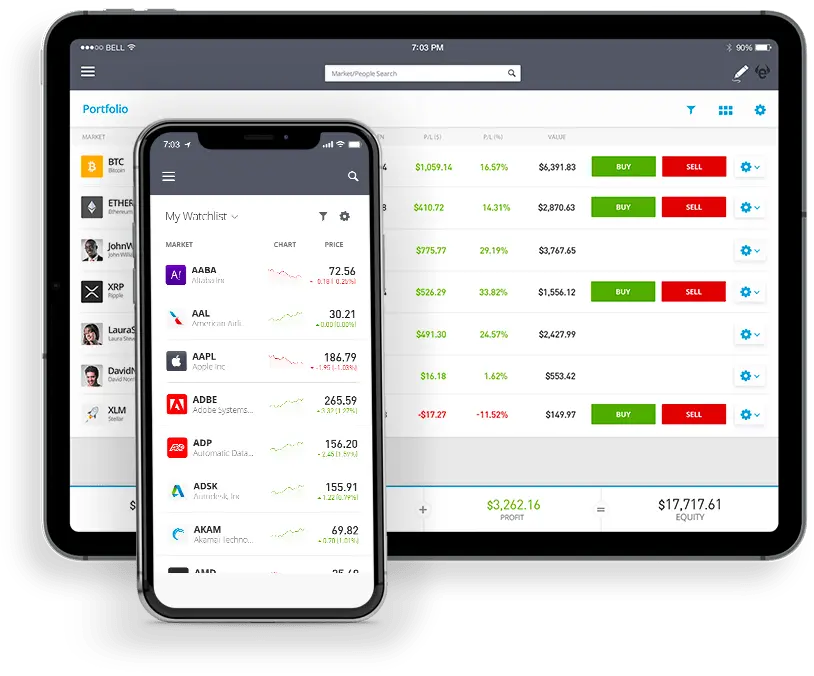To use eToro's demo account, sign up on the eToro platform. Once registered, select the "Virtual Portfolio" option. This allows you to practice trading with virtual funds.
Open an account!
61% of retail investor accounts lose money when trading CFDs with this provider. You should consider whether you can afford to take the high risk of losing your money.
Beginnings
When I first stumbled upon eToro, I was intrigued by its reputation as a global social trading platform. But, like many, I was hesitant to invest real money without a test run. Enter the demo account—a haven for beginners like me to explore the world of trading without financial risk.
Setting Up Your Demo Account
My journey with the eToro demo account began with:
- Registration: Visiting eToro's official website and signing up. A straightforward process that required just my email.
- Activation: Once logged in, I was pleasantly surprised to see an option to switch to "Demo" mode. This transitioned my dashboard into a simulation environment.
Navigating the Demo Dashboard
The first time I explored the demo dashboard, it felt like standing in the cockpit of a futuristic spacecraft:
- User Interface: Over time, I grew familiar with sections like the portfolio, watchlist, and markets.
- Tools and Features: I played around with charting tools and dived into the technical indicators, each providing a unique insight into the trading world.
Making My First Demo Trade
I still remember the thrill of making my first simulated trade:
- Selecting Assets: With a plethora of choices, from stocks to cryptocurrencies, I dabbled in a bit of everything.
- Trading: Setting my first buy order, understanding eToro leverage, and tinkering with stop loss and take profit parameters felt empowering.
Exploring Social Trading Features
This is where eToro truly shone for me:
- Copy People: Mimicking the trades of seasoned pros allowed me to gain insights into their strategies. I spent hours analyzing top traders, learning from their moves.
- Community Engagement: Engaging with other traders on the news feed provided a wealth of shared knowledge.
Risk Management in the Demo Environment
Despite it being a simulated environment, I approached it as if every virtual dollar was real.
I quickly learned the importance of discipline and setting boundaries in trading, making sure not to get carried away with the 'unreal' nature of the funds.
Switching Between Real and Demo Accounts
After gaining confidence, I toggled between the demo and real modes. Strategies I honed in the demo were adapted and refined for the real world, ensuring I was prepared for actual market dynamics.
Benefits of Using a Demo Account
From my experience:
- Risk-free Learning: I made mistakes, but without any real financial repercussions. Every mistake became a lesson.
- Strategy Testing: The freedom to experiment was invaluable. I could trial diverse strategies without commitment.
Limitations of the Demo Account
Over time, I noticed this: While the demo is fantastic, it's not an exact mirror of the live market. Factors like slippage and order execution speed can differ.
Tips and Best Practices
Here are some of the tips and best practices that I can give based from my journey in using eToro's virtual portfolio:
- Continuous Learning: The demo is a starting point. The real learning comes from diving deep, exploring, and staying updated with market news, which can also be found on the eToro app.
- Avoid Complacency: It's essential to remember that success in a demo doesn't always translate to real-world success.
Conclusion and Next Steps
Using eToro's demo account was one of my wisest decisions. It equipped me with knowledge and confidence. For anyone venturing into the world of trading, I'd recommend starting with the demo mode. And when you feel ready, take the leap into real trading, but always with caution and continuous learning.
eToro is a multi-asset platform which offers both investing in stocks and cryptoassets, as well as trading CFDs.
Please note that CFDs are complex instruments and come with a high risk of losing money rapidly due to leverage. 61% of retail investor accounts lose money when trading CFDs with this provider. You should consider whether you understand how CFDs work, and whether you can afford to take the high risk of losing your money.
This communication is intended for information and educational purposes only and should not be considered investment advice or investment recommendation. Past performance is not an indication of future results.
Copy Trading does not amount to investment advice. The value of your investments may go up or down. Your capital is at risk.
Don’t invest unless you’re prepared to lose all the money you invest. This is a high-risk investment and you should not expect to be protected if something goes wrong. Take 2 mins to learn more.
Crypto investments are risky and may not suit retail investors; you could lose your entire investment. Understand the risks here https://etoro.tw/3PI44nZ.
eToro USA LLC does not offer CFDs and makes no representation and assumes no liability as to the accuracy or completeness of the content of this publication, which hasbeen prepared by our partner utilizing publicly available non-entity specific information about eToro.


